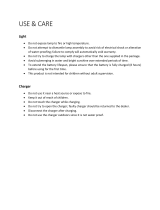
10. Do not attempt to open the charger. There are no customer serviceable parts inside.
Return to any authorized Black & Decker service center.
11. DO NOT incinerate the tool or batteries even if they are severely damaged or
completely worn out. The batteries can explode in a fire. Toxic fumes and materials
are created when lithium ion battery packs are burned.
12. Do not charge or use battery in explosive atmospheres, such as in the presence of
flammable liquids, gases or dust. Inserting or removing the battery from the charger
may ignite the dust or fumes.
13. If battery contents come into contact with the skin, immediately wash area with mild
soap and water. If battery liquid gets into the eye, rinse water over the open eye for
three minutes or until irritation ceases. If medical attention is needed, the battery
electrolyte is composed of a mixture of liquid organic carbonates and lithium salts.
WARNING: Burn hazard. Battery liquid may be flammable if exposed to spark or flame.
CHARGING PROCEDURE
IMPORTANT: The batteries in your tool are not fully charged at the factory. Before
attempting to charge them, thoroughly read all of the safety instructions.
• The charging port (5) is keyed to lock out other chargers. Align the tab in the charger plug
(7) with the key in the charging port.
• Insert charger plug into the charging port of
the tool as shown in figure B.
• Plug the charger into any standard 120 Volt
60 Hz electrical outlet.
• Let the tool charge initially for at least 16
hours. After the initial charge, your tool should
be fully charged in 12 hours from a fully
discharged condition. Recharge discharged
batteries as soon as possible after use or
battery life may be greatly diminished. For
longest battery life, do not discharge
batteries fully. It is recommended that the
batteries be recharged after each use.
WARNING: Do not use tool while it is connected to the charger.
WARNING: Fire Hazard. When disconnecting the charger from the tool, be sure to
unplug the charger from the outlet first, then disconnect the charger cord from the tool.
Important Charging Notes
1. Your tool was sent from the factory in an uncharged condition. Before attempting to
use it, it must be charged for at least 16 hours.
2. CAUTION: To reduce the risk of damage to the batteries, NEVER charge them
in an air temperature below 40°F (4,5°C) or above 105°F (40,5°C). Also, NEVER
charge them if the battery temperature is below 40°F (4,5°C) or above 105°F
(40,5°C). Longest life and best performance occurs when batteries are charged with
an air temperature of approximately 75°F (24°C).
3. While charging, the charger may hum and become warm to touch. This is a normal
condition and does not indicate a problem.
4. If the batteries do not charge properly—(1) Check current at receptacle by plugging in
a lamp or other appliance. (2) Check to see if receptacle is connected to a light
switch which turns power off when you turn out the lights. (3) Check that the charger
plug is fully inserted into the charger port on the tool. (4) If the receptacle is OK, and
you do not get proper charging, take or send the tool and charger to your local
Black & Decker service center. See Tools Electric in yellow pages.
5. The tool should be recharged when it fails to produce sufficient power on jobs which
were easily done previously. Battery life may be greatly diminished if batteries are
discharged deeply. DO NOT CONTINUE using product with its batteries in a depleted
condition. Recharge discharged batteries promptly.
6. To maximize battery life:
a. Do not fully discharge batteries.
b. Fully recharge batteries after each use.
B
5
7
6










